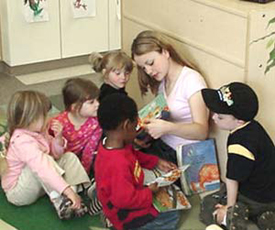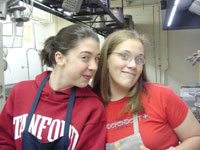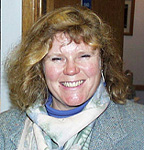INNOVATIVE TEACHING SHOWCASE
Screen Play: Reading Film
Introduction
When it's spring in Bellingham, it's time to unleash the energy and enthusiasm of 202 local middle school students, 27 Woodring College of Education students and 14 parent volunteers. Each year, this group ventures out to approximately 30 community partners, where they learn about community issues and provide services. Sound like the recipe for pandemonium? Although it may sound crazy at the outset, it's the basis for "Project Connect" a six-year collaborative service-learning project I've facilitated with partner teachers Callie Hart from Fairhaven Middle School, and Sharece Steinkamp, and Tina Allsop from Shuksan Middle School. Admittedly, the scope of the project makes it seem, at times, nearly impossible to pull off, but the resulting depth of learning for everyone involved makes it more than worth our combined efforts.
In the beginning . . .
--Dr. Angie Harwood
This ambitious project had its rather modest beginnings in a one-hour presentation to students in my Social Studies Methods course seven springs ago. At that point, I was exploring how to help future social studies teachers bring their subject alive for students, and had read about service-learning in social studies journals. Fortunately, Western's Center for Service-Learning was able to provide two experts Ė then Faculty Director Susanne James and then Program Coordinator Lisa Moulds. They provided my students with a crash-course on the definition and possibilities of doing service-learning. It might have all ended before it began, except that the concept caught in the brain of one of my students, Callie Hart. The following autumn, I was assigned as Callie's supervisor during her student teaching and we attended a state-level middle school educator's conference in Yakima. She heard a presentation on service-learning by Whatcom Middle School teacher Barb Storms, and decided to launch her own service-learning project during her student teaching. With permission from her mentor teacher, Karolyn Schwartz, and help locating community partners from Western's Center for Service-Learning (see Helpful Hints for Community Partners), the seeds of what became Project Connect were planted.
Callie was hired the following year for a full-time teaching position at Fairhaven Middle School, and a second student teaching intern, Tina Allsop, was assigned to work with Karolyn Schwartz. After hearing about the service-learning project, Tina decided she wanted her students to participate, and it was at that point that Western Washington University students became involved. In bringing my pre-service teachers into the project, I saw a unique opportunity for them to not only practice authentic teaching skills in a unique environment, but for them to learn about how to facilitate service-learning projects in their future classrooms.
How Project Connect Works

The program implemented by local middle school teachers features strong academic components that are designed to meet state and national learning standards while students provide sustained, needs-based service to the community. In two-hour "core" period classes that combine Language Arts and Social Studies topics, middle school students research current community issues and engage in several learning activitiesóranging from producing bills about their service topics for a Mock Congress to preparing resumes and cover lettersódesigned to prepare them for service. Woodring College of Education students opt to participate in the project to fulfill practicum credit or as an elective. Pre-service teachers are also afforded the option of participating in a Service-Learning Seminar which is taught during the quarter they are engaging in service. The seminar is intended to help students gain knowledge about key elements of service-learning pedagogy and to engage in discussion about what they are learning.
--Woodring College Student
Both the 8th-graders and Western students are given the option of topic areas for their service. These include working with the elderly, youth, pets and animals or social service or environmental agencies. Western students meet their groups of 8th-graders at the school site and transport them to service sites. Groups make two-hour site visits for six weeks during spring quarter. The Western students engage in service alongside the middle-schoolers, providing on-site problem-solving, serving as a liaison between sites and the schools, and helping to facilitate a wide range of learning outcomes. An orientation session is held for the Western learning facilitators to help them understand these roles.
Written reflection is a key element for both Service-Learning Seminar participants and the 8th grade students. Each week different journal prompts are provided for the 8th graders asking them to respond to a range of questions. They describe their sites and the people they meet there, analyze how they are making a difference, report on career opportunities and explain how their experience has affected them. The Western pre-service teachers are responsible for reading and responding to the 8th-graders' journals. Woodring seminar participants write about what they are learning with their service issue, middle schoolers, teaching, and themselves.

At the completion of the site visits, each school has a celebration of student learning. Students at Fairhaven make presentations in which they indicate which of the seven essential Bellingham School District goals they have achieved. For the past two years, the 8th graders from Shuksan have visited Western's campus and presented their final projects, with invitations going out to the campus and community partners. This enables students to reach an authentic audience and share their work with those who made it possible.
Results of Project Connect
--Fairhaven Middle School Student
Both University and middle school students learn a tremendous amount from their service. Eighth-graders gain increased communication skills, a greater knowledge of community issues and agencies, career goal clarification, and an awareness of the responsibility of citizenship. The students, through reflection and final projects, recognize their growth. Western students learn practical and hands-on knowledge about how to use service-learning approaches in their future classrooms, practice student management and communication skills, and clarify their own goals as teachers. The words of the students themselves tell this story most powerfully. An additional but equally important outcome is the benefit to our community partners (see the example community partner survey). Many of them gained not only help providing services, but were renewed by the optimism and energy of the their student partners.
Personal Benefits of Doing Service-Learning

As the project co-facilitator with my public school colleagues, I have gained a tremendous amount from my participation in Project Connect. I am on-site with the project two days each week spring quarter, and make it a point to serve as a learning facilitator at each school. Doing so keeps my middle-school teaching skills fresh and helps me stay directly connected with adolescents and their issues. I have also had the opportunity to work in numerous agencies through my participation in this project, which has given me a greater appreciation for the diversity of the Bellingham community and local issues. The 8th-graders, and their willingness to continue service, have inspired me to pursue my own personal service at Womancare Shelter as well.
Engaging in service-learning has been professionally beneficial as well. We have had the opportunity to present the project to audiences of educators at several national conferences, including the National Middle School Association, National Council for the Social Studies, National Youth Leadership Council, and the Campus Compact Continuums Conference. My work with NCSS enabled me to prepare and present a professional in-service workshop on service-learning at Western's campus for a nationwide group of teachers.
Resulting publication opportunities have included a position paper for the Education Commission of the States and chapters in books published by NCSS and The American Association of Higher Education. With collaborating teacher Callie Hart, I was invited to participate in a federal Contextual Teaching and Learning grant house at the University of Washington, which in turn led to my participation in an international teacher education project in Suribya, Indonesia. I have also been involved in a National Service-Learning in Teacher Education Partnership grant program. All in all, the creating and implementation of this project has been the most personally and professionally rewarding of all my endeavors at Western.

↑ Go to top


